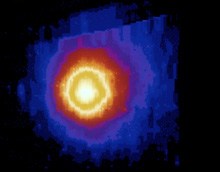http://science.nasa.gov/headlines/y2009/06mar_keplerlaunch.htm?list965414
NASA's Kepler Mission Rockets to Space in Search of Other Earths
*March 6, 2009:* NASA's Kepler mission successfully launched into space from Cape Canaveral Air Force Station, Fla., aboard a United Launch Alliance Delta II at 10:49 p.m. EST, Friday. Kepler is designed to find the first Earth-size planets orbiting stars at distances where water could pool on the planet's surface. Liquid water is believed to be essential for the formation of life.
"It was a stunning launch," said Kepler Project Manager James Fanson of NASA's Jet Propulsion Laboratory in Pasadena, Calif. "Our team is thrilled to be a part of something so meaningful to the human race -- Kepler will help us understand if our Earth is unique or if others like it are out there."
snip
----------------------------------------------------------------------------------
Was glad to see the launch was successful.
It has been a long time in getting there with a number of proposals before getting accepted.
William Borucki, the mission's science principal investigator at NASA's Ames Research Center at Moffett
Field, Calif. Borucki has worked on the mission for 17 years
Just take a look at the news story time line, you will see it goes back to 1999.
http://kepler.nasa.gov/about/news.html
I had the opportunity to do some support work on that Technology Demonstration.
I wrote some LabVIEW programs to control some of the environmental parameters to housing for the Technology Demonstration.
http://kepler.nasa.gov/sci/techdemo/index.html
While I was still at NASA Ames Research Center, the Kepler folks took over the old Pioneer Operations/Computer Center and I got to have fun removing all the old computers, equipment, and under floor wiring. A nice office space went in after the raised computer floor was removed.
Brings back memories of all the old stuff I maintained.
If you don't mind waiting for the down load time of a bunch of pictures here is a link.
http://lkellogg.vttoth.com/LarryRussellKellogg/PioneerPic.html
The Kepler web site has changed over the years.
You might care to check out what they have now.
http://kepler.nasa.gov/
Thanks for looking up with me.
Larry Kellogg
Web Site: http://lkellogg.vttoth.com/LarryRussellKellogg/
BlogSpot: http://kelloggserialreports.blogspot.com/
RSS link: http://kelloggserialreports.blogspot.com/atom.xml
Newsletter: https://news.altair.com/mailman/listinfo/lunar-update
==============================================================
http://www.nasa.gov/home/hqnews/2009/mar/HQ_09-052_Kepler_launches.html
NASA's Kepler Mission Rockets to Space in Search of Other Earths
March 7, 2009
J.D. Harrington
Headquarters, Washington
202-358-5241
j.d.harrington@nasa.gov
Whitney Clavin
Jet Propulsion Laboratory, Pasadena, Calif.
818-354-4673
whitney.clavin@jpl.nasa.gov
Michael Mewhinney
Ames Research Center, Moffett Field,Calif.
650-604-3937
michael.s.mewhinney@nasa.gov
George Diller
Kennedy Space Center, Fla.
321-861-7643
george.h.diller@nasa.gov
RELEASE: 09-052
NASA'S KEPLER MISSION ROCKETS TO SPACE IN SEARCH OF OTHER EARTHS
CAPE CANAVERAL, Fla. -- NASA's Kepler mission successfully launched
into space from Cape Canaveral Air Force Station, Fla., aboard a
United Launch Alliance Delta II at 10:49 p.m. EST, Friday. Kepler is
designed to find the first Earth-size planets orbiting stars at
distances where water could pool on the planet's surface. Liquid
water is believed to be essential for the formation of life.
"It was a stunning launch," said Kepler Project Manager James Fanson
of NASA's Jet Propulsion Laboratory in Pasadena, Calif. "Our team is
thrilled to be a part of something so meaningful to the human race --
Kepler will help us understand if our Earth is unique or if others
like it are out there."
Engineers acquired a signal from Kepler at 12:11 a.m. Saturday, after
it separated from its spent third-stage rocket and entered its final
sun-centered orbit, trailing 950 miles behind Earth. The spacecraft
is generating its own power from its solar panels.
"Kepler now has the perfect place to watch more than 100,000 stars for
signs of planets," said William Borucki, the mission's science
principal investigator at NASA's Ames Research Center at Moffett
Field, Calif. Borucki has worked on the mission for 17 years.
"Everyone is very excited as our dream becomes a reality. We are on
the verge of learning if other Earths are ubiquitous in the galaxy."
Engineers have begun to check Kepler to ensure it is working properly,
a process called "commissioning" that will take about 60 days. In
about a month or less, NASA will send up commands for Kepler to eject
its dust cover and make its first measurements. After another month
of calibrating Kepler's single instrument, a wide-field charge-couple
device camera, the telescope will begin to search for planets.
snip
==============================================================
http://kepler.nasa.gov/sci/techdemo/index.html
Technology Demonstration
The Kepler Mission depends on the ability to reliably measure the very small relative change in brightness of a star caused by the transit of an Earth-size planet. We have constructed a high-fidelity Testbed Facility of the end-to-end photometry system. This has been used to show that under all of the expected operating conditions which can add noise to the measurements, the signature of an Earth-size transit is readily detectable.
This page provides an overview of the the technology demonstration that has been performed. It is followed by a page on the laboratory facility that has been constructed and then by a page that discusses the results.
snip
==============================================================
WHAT THE MIND CAN CONCEIVE, AND BELIEVE, IT WILL ACHIEVE - LRK
==============================================================




